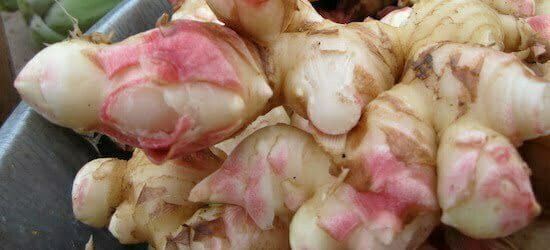The onset of fall brings young ginger to area farmers tailgate markets. Though native to more tropical climates, ginger actually grows quite well in Appalachia and has become increasingly popular among Western North Carolina farmers over the past decade. You can get it now from Highgate Farm at Black Mountain Tailgate Market, West Asheville Tailgate Market, and River Arts District Farmers Market; New Roots Market Garden at ASAP Farmers Market; and Lee’s One Fortune Farm, at all of the above markets plus East Asheville Tailgate Market.
This fresh, young ginger differs from the mature, more dried-out version you typically purchase at the grocery store. Its papery skin peels easily by scraping with the edge of a spoon. Or go ahead and eat it skin and all, as young ginger skin isn’t bitter or tough. Ginger is also less fibrous when it’s young. Freezing it whole is an easy way to keep it to use all year and makes it easy to grate into recipes. But here are two other methods for preserving your ginger.
Pickle it. Just like the palate cleanser served alongside your sushi takeout, you can pickle ginger and have it on hand for your own sushi-making adventures. Young ginger will have a pinkish cast to it, though not the artificial salmon color sometimes found in grocery store sushi containers. Older ginger will remain golden in color. Either is fine!
The key here is to shave ginger into super thin, almost transparent slices. A vegetable peeler is your best tool for this. Divide ginger into one to two-inch sections and slice lengthwise. Massage ginger slices in a bowl with salt and let it sit overnight in the refrigerator. Rinse in cold water and place in a canning jar. Combine 1/2 cup rice vinegar, 3 tablespoons of water, and 1 1/2 tablespoons of sugar or honey in a pot and bring to a boil. Pour brine over the ginger, pressing down so everything is completely submerged. Cover and refrigerate. Wait about 48 hours before sampling; the flavor will intensify the longer you wait. Store pickled ginger in the refrigerator for up to six months.
Candy it. This method yields two great ginger products: candied ginger and ginger syrup. Candied ginger is a great snack or can settle and upset stomach. Ginger syrup can be added to tea in place of sweetener, combined with seltzer or club soda for a non-fermented take on ginger ale, or drizzled over fruit, ice cream, pancakes, or whatever else you’re craving.
To start, slice ginger into rounds about 1/8-inch thick or even thinner. Place in a pot and cover with water. Bring to a boil, then reduce heat and simmer for 10 minutes. Drain and repeat once more. In a wide pot, cover the ginger with water, measuring how many cups of water you add as you go. Add an equal amount of sugar by volume and a pinch of salt. Bring to a boil and boil gently for 10 to 15 minutes. A wide pot helps to keep the ginger in a shallow layer to candy evenly. Strain the ginger, reserving the syrup for other uses. In a bowl, toss the strained ginger with additional sugar to coat. Place in a single layer on a drying rack or parchment paper. Drying time can vary from about two hours to overnight, depending on how thick your slices are. Once ginger candies are no longer tacky, they can be stored in an airtight container for three months—if they last that long.
Tailgate markets now are also stocked with dark leafy greens, like kale, chard, and mustards; a panoply of winter squash; staples such as carrots, potatoes, and onions; fruits like apples, pears, figs, and grapes; and the last of the season’s peppers, tomatoes, and eggplant. As always, you’ll also find meat, eggs, bread, cheese, fermented products, baked goods, and beverages. Find more details about farms and markets throughout the region in ASAP’s online Local Food Guide.
Fresh at Farmers Markets This Week

